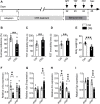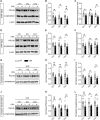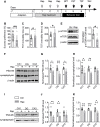mTORC1 Signaling Pathway Mediates Chronic Stress-Induced Synapse Loss in the Hippocampus
- PMID: 34987410
- PMCID: PMC8722735
- DOI: 10.3389/fphar.2021.801234
mTORC1 Signaling Pathway Mediates Chronic Stress-Induced Synapse Loss in the Hippocampus
Abstract
Background: The mechanistic target of rapamycin complex 1 (mTORC1) signaling has served as a promising target for therapeutic intervention of major depressive disorder (MDD), but the mTORC1 signaling underlying MDD has not been well elucidated. In the present study, we investigated whether mTORC1 signaling pathway mediates synapse loss induced by chronic stress in the hippocampus. Methods: Chronic restraint stress-induced depression-like behaviors were tested by behavior tests (sucrose preference test, forced swim test and tail suspension test). Synaptic proteins and alternations of phosphorylation levels of mTORC1 signaling-associated molecules were measured using Western blotting. In addition, mRNA changes of immediate early genes (IEGs) and glutamate receptors were measured by RT-PCR. Rapamycin was used to explore the role of mTORC1 signaling in the antidepressant effects of fluoxetine. Results: After successfully establishing the chronic restraint stress paradigm, we observed that the mRNA levels of some IEGs were significantly changed, indicating the activation of neurons and protein synthesis alterations. Then, there was a significant downregulation of glutamate receptors and postsynaptic density protein 95 at protein and mRNA levels. Additionally, synaptic fractionation assay revealed that chronic stress induced synapse loss in the dorsal and ventral hippocampus. Furthermore, these effects were associated with the mTORC1 signaling pathway-mediated protein synthesis, and subsequently the phosphorylation of associated downstream signaling targets was reduced after chronic stress. Finally, we found that intracerebroventricular infusion of rapamycin simulated depression-like behavior and also blocked the antidepressant effects of fluoxetine. Conclusion: Overall, our study suggests that mTORC1 signaling pathway plays a critical role in mediating synapse loss induced by chronic stress, and has part in the behavioral effects of antidepressant treatment.
Keywords: chronic restraint stress; depression; fluoxetine; mammalian target of rapamycin; postsynaptic density protein 95.
Copyright © 2021 Luo, Ye, Fang, Li, Xia, Liu, Lin, Huang, Zhu, Huang, Tan, Zhang, Liu, Zhou and Shen.
Conflict of interest statement
The authors declare that the research was conducted in the absence of any commercial or financial relationships that could be construed as a potential conflict of interest.
Figures






Similar articles
-
Effects of Chronic LY341495 on Hippocampal mTORC1 Signaling in Mice with Chronic Unpredictable Stress-Induced Depression.Int J Mol Sci. 2022 Jun 8;23(12):6416. doi: 10.3390/ijms23126416. Int J Mol Sci. 2022. PMID: 35742857 Free PMC article.
-
Activation of mTORC1 Signaling Cascade in Hippocampus and Medial Prefrontal Cortex Is Required for Antidepressant Actions of Vortioxetine in Mice.Int J Neuropsychopharmacol. 2023 Oct 19;26(10):655-668. doi: 10.1093/ijnp/pyad017. Int J Neuropsychopharmacol. 2023. PMID: 37025079 Free PMC article.
-
Increased Homer1-mGluR5 mediates chronic stress-induced depressive-like behaviors and glutamatergic dysregulation via activation of PERK-eIF2α.Prog Neuropsychopharmacol Biol Psychiatry. 2019 Dec 20;95:109682. doi: 10.1016/j.pnpbp.2019.109682. Epub 2019 Jun 29. Prog Neuropsychopharmacol Biol Psychiatry. 2019. PMID: 31265863
-
Effects of escitalopram and paroxetine on mTORC1 signaling in the rat hippocampus under chronic restraint stress.BMC Neurosci. 2017 Apr 26;18(1):39. doi: 10.1186/s12868-017-0357-0. BMC Neurosci. 2017. PMID: 28446154 Free PMC article.
-
Remodeling of axo-spinous synapses in the pathophysiology and treatment of depression.Neuroscience. 2013 Oct 22;251:33-50. doi: 10.1016/j.neuroscience.2012.09.057. Epub 2012 Oct 2. Neuroscience. 2013. PMID: 23036622 Free PMC article. Review.
Cited by
-
A whole transcriptome profiling analysis for antidepressant mechanism of Xiaoyaosan mediated synapse loss via BDNF/trkB/PI3K signal axis in CUMS rats.BMC Complement Med Ther. 2023 Jun 15;23(1):198. doi: 10.1186/s12906-023-04000-0. BMC Complement Med Ther. 2023. PMID: 37322430 Free PMC article.
-
Dapagliflozin mitigates cognitive deficits in a rat model of chronic restrained stress by addressing insulin resistance and mitochondrial dysfunction.Naunyn Schmiedebergs Arch Pharmacol. 2025 May 21. doi: 10.1007/s00210-025-04136-5. Online ahead of print. Naunyn Schmiedebergs Arch Pharmacol. 2025. PMID: 40397120
-
Neuroprotective mechanisms of luteolin in glutamate-induced oxidative stress and autophagy-mediated neuronal cell death.Sci Rep. 2024 Apr 2;14(1):7707. doi: 10.1038/s41598-024-57824-2. Sci Rep. 2024. PMID: 38565590 Free PMC article.
-
Ablated Sonic Hedgehog Signaling in the Dentate Gyrus of the Dorsal and Ventral Hippocampus Impairs Hippocampal-Dependent Memory Tasks and Emotion in a Rat Model of Depression.Mol Neurobiol. 2024 Jul;61(7):4352-4368. doi: 10.1007/s12035-023-03796-9. Epub 2023 Dec 12. Mol Neurobiol. 2024. PMID: 38087166
-
Aged-Related Changes in Microglia and Neurodegenerative Diseases: Exploring the Connection.Biomedicines. 2024 Aug 2;12(8):1737. doi: 10.3390/biomedicines12081737. Biomedicines. 2024. PMID: 39200202 Free PMC article. Review.
References
-
- Admon R., Leykin D., Lubin G., Engert V., Andrews J., Pruessner J., et al. (2013). Stress-induced Reduction in Hippocampal Volume and Connectivity with the Ventromedial Prefrontal Cortex Are Related to Maladaptive Responses to Stressful Military Service. Hum. Brain Mapp. 34 (11), 2808–2816. 10.1002/hbm.22100 - DOI - PMC - PubMed
-
- Armbrecht E., Shah R., Poorman G. W., Luo L., Stephens J. M., Li B., et al. (2021). Economic and Humanistic Burden Associated with Depression and Anxiety Among Adults with Non-communicable Chronic Diseases (NCCDs) in the United States. J. Multidiscip Healthc. 14, 887–896. 10.2147/JMDH.S280200 - DOI - PMC - PubMed
LinkOut - more resources
Full Text Sources

